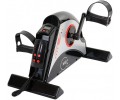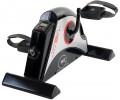Load system
The design of a system that creates resistance on the flywheel of an exercise bike and the corresponding load during training. The following options are currently in use:
—
Mechanical. The operation of this system is similar to the brakes of a car: special brake pads are pressed against the flywheel, and by changing the force of pressing, the resistance to movement also changes. The advantages of mechanical load systems are simplicity and low cost, reliability, the ability to create high resistance for large loads, as well as autonomy — they do not require power, and the design can be done with a small battery for auxiliary electronics (see "Power source"). On the other hand, the pads, due to friction against the flywheel, create a certain noise, which can lead to inconvenience; they also wear out over time. The mechanical system is used mainly in inexpensive models of exercise bikes.
—
Magnetic. In systems of this type, the resistance changes due to permanent magnets: bringing them closer to the flywheel or moving away from it, you can change the load during movement. Magnetic systems predominantly do not require a power source; at the same time, they provide smoother adjustment and practically do not create noise. At the same time, this variety is poorly suited for training professionals — it is not capable of creating a serious load (although it is usually quite enough for domestic
...use).
— Electromagnetic. This type of system is considered the most advanced. The principle of their operation is similar to magnetic ones (see above). However, instead of permanent magnets, stationary electromagnets are used in this case. The load, on the other hand, changes due to a change in the strength of the current passing through the windings of the electromagnets: the stronger the current, the stronger the magnetic field and, accordingly, the higher the resistance to movement. Thanks to this, electromagnetic models can provide very high load levels, while maintaining one of the main advantages of classical magnetic systems — complete noiselessness. The main disadvantage is the need for a power supply, which is provided either by connecting to the mains or by installing a built-in generator (see "Power source"). These exercise bikes are quite expensive.Load levels
The number of fixed load levels (pedal resistance during movement) provided in the design of the exercise bike. The more such levels provided in the design, the wider the possibilities for adjusting the load and the more accurately it can be adjusted to the requirements of a particular user. At the same time, the abundance of adjustments accordingly affects the price.
Power source
The type of power source used in the exercise bike.
—
Mains. Powered by a standard 230 V power supply. Such power allows you not to worry about replacing or recharging dead batteries — the exercise bike will work as long as there is electricity in the house. In addition, it is suitable for models with any load system, even electromagnetic (for more details, see "Load system"), while such devices are much cheaper than models with generators (see below). The main disadvantages are the dependence on the outlet and the need to use wires, which can limit mobility and get in the way. However, these shortcomings do not cause significant inconvenience.
—
Battery. The exercise bike is powered by replaceable batteries. The main advantage such exercise bikes can be installed anywhere without worrying about the availability of sockets and laying the power cord. On the other hand, the power of the batteries is very limited, and they are only suitable for models with mechanical or magnetic load systems (see "Load system" for more details), where power is required only for the computer. In addition, the battery life is not infinite, and they need to be changed or recharged periodically.
— Built-in generator. The exercise bike is powered by its built-in generator, which is driven by the rotation of the flywheel. In other words, when using such a model, the user himself generates the energy
...required for work. To turn on the exercise bike with a built-in generator, is enough to turn the flywheel several times. This type of power supply combines the advantages of the two above. On the one hand, it is autonomous, on the other hand, it has sufficient power even to provide energy to electromagnetic load systems (for more details, see "Load system"). At the same time, this feature significantly increases the weight, and most importantly, the cost of the device, and therefore is found only in premium models.
